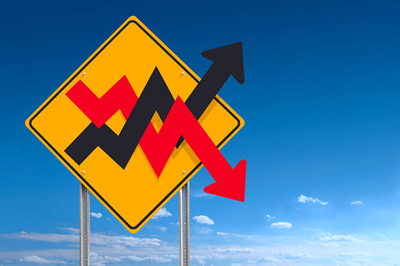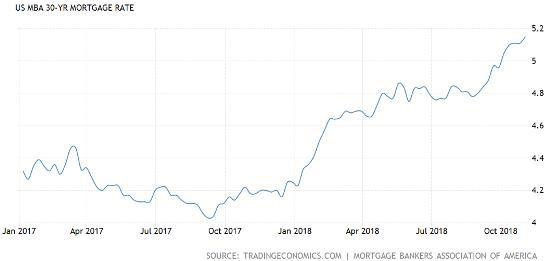The Election’s Finally Over. Now Things Can Go Back To “Normal”: Rising Interest Rates, Rising Debt, Rising Volatility
John Rubino
 As contentious as the US midterm elections were, there was never a scenario in which they mattered. Any possible configuration of Republicans and Democrats in the House and Senate would have yielded pretty much the same economy going forward: Ever-higher debt, upward trending interest rates and (through the combination of those two) rising volatility. As contentious as the US midterm elections were, there was never a scenario in which they mattered. Any possible configuration of Republicans and Democrats in the House and Senate would have yielded pretty much the same economy going forward: Ever-higher debt, upward trending interest rates and (through the combination of those two) rising volatility.
So with the sideshow now in the rear view mirror, we can get back to our new normal. From this morning’s media reports:
U.S. three-month LIBOR climbs to decade high
(Reuters) – A key gauge of what banks charge each other to borrow dollars for three months increased to its highest level in a decade on Wednesday ahead of the U.S. Federal Reserve’s two-day policy meeting that will begin later in the day.
The London interbank offered rate to borrow three-month dollars climbed nearly 1 basis point to 2.60113 percent following a 0.2 basis point gain on Tuesday.
Three-month LIBOR has risen in 15 of the last 16 sessions, prompted by the Fed’s rate hikes, rising U.S. government borrowing and a shrinking Federal Reserve balance sheet.
LIBOR is the benchmark rate for $200 trillion of dollar-denominated financial products, mainly interest rate swaps and floating-rate loans.
———————–
Mortgage applications drop to 4-year low as interest rates hit 8-year high
(CNBC) – Total mortgage application volume fell 4 percent last week from the previous week. Volume was 16 percent lower than a year ago.
Rising interest rates are now clearly taking their toll on potential homebuyers. Total mortgage application volume fell 4 percent last week from a week earlier and plunged 16 percent from a year ago, according to the Mortgage Bankers Association’s seasonally adjusted index.

Mortgage applications to purchase a home led the volume lower, falling 5 percent for the week to the lowest level in two years. Purchase applications were 0.2 percent lower than a year ago.
Mortgage applications to refinance a home loan have been falling for more than a year and fell 3 percent more last week. Volume was 33 percent lower than a year ago.
———————–
Dow climbs as midterm elections fall in line with forecasts
(MarketWatch) – U.S. stocks rose in early Wednesday trade, following closely watched midterm elections that delivered no major surprises, and will lead to divided government in Washington come January.
The Dow Jones Industrial Average gained 160 points, or 0.6%, to 25,790, while the S&P 500 index ESZ8, +1.21% climbed nearly 24 points, or 0.9%, to 2,779. The Nasdaq Composite Index NQZ8, +2.01% jumped 94 points, or 1.3%, to 7,470. DJIA, +0.99%.
U.S. midterm election results largely fell in line with forecasters’ prediction, with Democrats set to take control of the House and Republicans on track to strengthen their grip on the Senate.
Notice the seeming contradiction? Interest rates are rising on pretty much everything everywhere, but stocks jump on the prospect of a “divided government” which guarantees a continuation of the status quo.
The reality of the situation is the same as it was in October: As long as unemployment stays low and wages keep rising, interest rates will have to go up, either because the Fed feels compelled to boost short-term rates or bond investors demand higher long-term yields to offset rising wage inflation, or both.
History teaches that this late-cycle dynamic continues until it breaks a major piece of the leveraged speculating community, the collapse of which shifts the dominant mindset to “risk off” (i.e., from BTFD to STFR).
Then the rollercoaster heads down the other side of the mountain. This exact thing would have happened had the Republicans held the House or had the Democrats won both House and Senate. The system is on autopilot and it matters exactly not at all which party or which configuration of inmates is running the asylum.

DollarCollapse.com is managed by John Rubino, co-author, with James Turk, of The Money Bubble (DollarCollapse Press, 2014) andÊThe Collapse of the Dollar and How to Profit From It (Doubleday, 2007), and author of Clean Money: Picking Winners in the Green-Tech Boom (Wiley, 2008), How to Profit from the Coming Real Estate Bust (Rodale, 2003) and Main Street, Not Wall Street (Morrow, 1998). After earning a Finance MBA from New York University, he spent the 1980s on Wall Street, as a Eurodollar trader, equity analyst and junk bond analyst. During the 1990s he was a featured columnist with TheStreet.com and a frequent contributor to Individual Investor, Online Investor, and Consumers Digest, among many other publications. He currently writes for CFA Magazine.
dollarcollapse.com
| 



